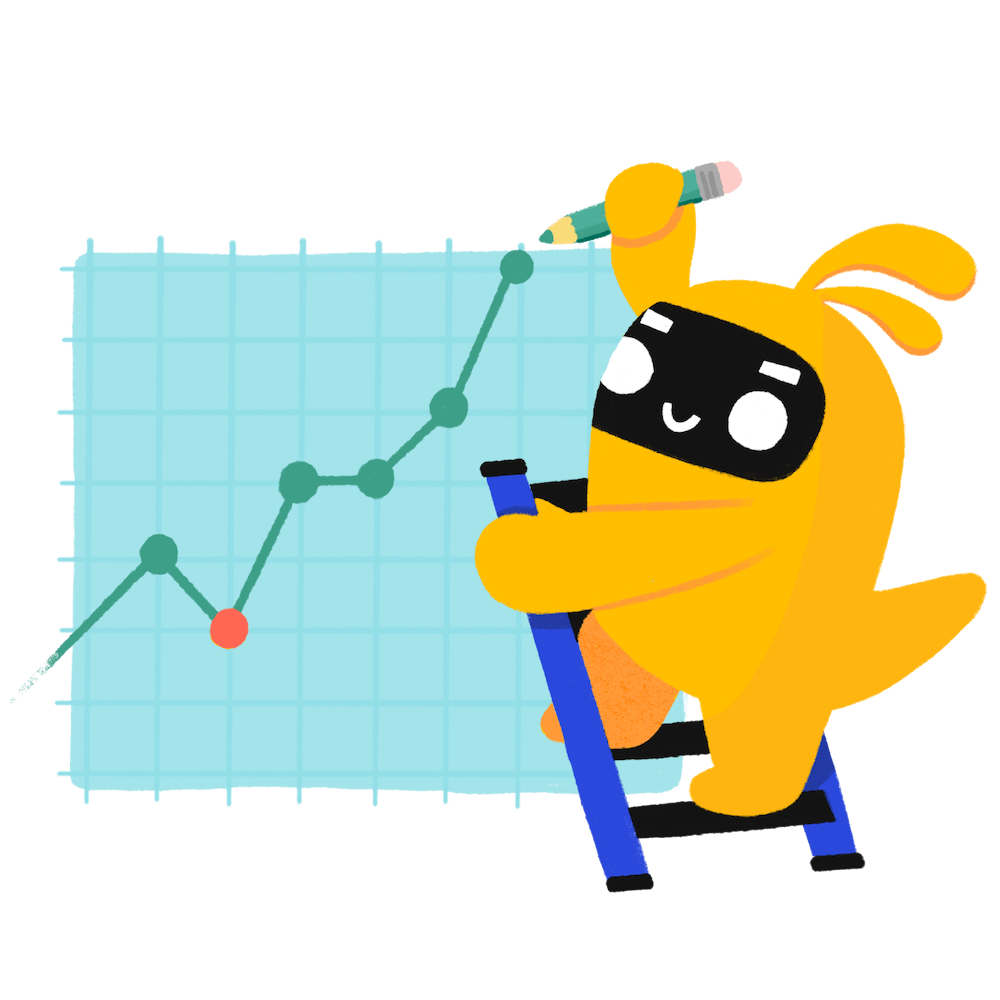5 customisable OKR examples for Strategic Initiative Team
What are Strategic Initiative Team OKRs?
The OKR acronym stands for Objectives and Key Results. It's a goal-setting framework that was introduced at Intel by Andy Grove in the 70s, and it became popular after John Doerr introduced it to Google in the 90s. OKRs helps teams has a shared language to set ambitious goals and track progress towards them.
Crafting effective OKRs can be challenging, particularly for beginners. Emphasizing outcomes rather than projects should be the core of your planning.
We have a collection of OKRs examples for Strategic Initiative Team to give you some inspiration. You can use any of the templates below as a starting point for your OKRs.
If you want to learn more about the framework, you can read our OKR guide online.
Building your own Strategic Initiative Team OKRs with AI
While we have some examples available, it's likely that you'll have specific scenarios that aren't covered here. You can use our free AI generator below or our more complete goal-setting system to generate your own OKRs.
Feel free to explore our tools:
- Use our free OKR generator
- Use Tability, a complete platform to set and track OKRs and initiatives, including a GPT-4 powered goal generator
Our customisable Strategic Initiative Team OKRs examples
You will find in the next section many different Strategic Initiative Team Objectives and Key Results. We've included strategic initiatives in our templates to give you a better idea of the different between the key results (how we measure progress), and the initiatives (what we do to achieve the results).
Hope you'll find this helpful!
1. OKRs to enhance capability as an institutional research analyst in higher education
Enhance capability as an institutional research analyst in higher education
Attend 3 professional development webinars on higher education research analysis techniques
Participate and take notes during each webinar
Sign up for the chosen webinars
Identify 3 webinars focused on higher education research analysis techniques
Mentor and guide 2 junior research analysts to improve their capability development
Provide direct training on necessary software/tools
Develop a personalized growth plan for each analyst
Establish regular weekly meetings for guidance and feedback
Develop, present, and implement 1 strategic initiative to improve research methodologies
Identify weakness in current research methodologies
Create strategic initiative for process improvement
Present and implement strategy to team
2. OKRs to support CEO in executing strategic initiatives and tracking progress
Enhance CEO's support for executing the company's strategic initiatives
Conduct regular progress reports and adjust strategies accordingly
Collaborate with CEO to ensure high-quality strategic execution
Improve CEO's communication with cross-functional teams
Develop a tracking system for CEO's strategic initiatives
3. OKRs to implement strategic initiatives to improve execution and value realization
Implement strategic initiatives to improve execution and value realization
Enhance stakeholder satisfaction by 10% through better strategic alignment
Identify areas of misalignment and develop improvement plans
Conduct a thorough review of current strategic alignment methods
Implement changes and track stakeholders' satisfaction growth
Achieve a 15% rise in measurable value from implemented initiatives
Identify areas for initiative implementation with the maximum benefit potential
Establish a system to track measurable value growth
Develop and execute strategies for selected initiatives
Increase strategic project completion rate by 20%
Conduct regular team meetings for effective communication and updates
Provide additional training to improve employee project handling skills
Implement project management software to track and streamline tasks
4. OKRs to boost participation in wellness events through strategic alignment
Boost participation in wellness events through strategic alignment
Ensure 80% of participants complete post-event satisfaction surveys
Send reminder emails regularly to encourage completion
Send out satisfaction surveys immediately following the event
Offer incentives for completing the survey
Increase registration for wellness events by 15%
Send personalized email invitations to past participants
Collaborate with local influencers for event promotion
Develop engaging social media campaigns promoting wellness events
Enhance engagement during wellness events by 25%
Offer small incentives for active participation or greater attendance
Add interactive health-related games or quizzes to wellness events
Promote wellness events through all available internal channels
5. OKRs to enhance stakeholder synergy and expedite strategic initiatives
Enhance stakeholder synergy and expedite strategic initiatives
Arrange and conduct at least 6 collaborative meetings with key stakeholders
List and identify six key stakeholders for collaboration
Develop and present meeting agendas for comprehensive discussions
Schedule meetings with stakeholders at convenient times
Develop a process for monitoring project timelines and achieving 90% on-time completion
Review progress regularly and adjust plans as needed
Establish project deadlines and key milestones
Implement a project management tracking system
Obtain feedback from stakeholders to increase project alignment by 20%
Analyze the collected feedback and identify alignment opportunities
Schedule individual meetings for more in-depth feedback
Design and distribute a survey to stakeholders for their project feedback
Strategic Initiative Team OKR best practices to boost success
Generally speaking, your objectives should be ambitious yet achievable, and your key results should be measurable and time-bound (using the SMART framework can be helpful). It is also recommended to list strategic initiatives under your key results, as it'll help you avoid the common mistake of listing projects in your KRs.
Here are a couple of best practices extracted from our OKR implementation guide 👇
Tip #1: Limit the number of key results
The #1 role of OKRs is to help you and your team focus on what really matters. Business-as-usual activities will still be happening, but you do not need to track your entire roadmap in the OKRs.
We recommend having 3-4 objectives, and 3-4 key results per objective. A platform like Tability can run audits on your data to help you identify the plans that have too many goals.
 Tability's audit dashboard will highlight opportunities to improve OKRs
Tability's audit dashboard will highlight opportunities to improve OKRsTip #2: Commit to weekly OKR check-ins
Don't fall into the set-and-forget trap. It is important to adopt a weekly check-in process to get the full value of your OKRs and make your strategy agile – otherwise this is nothing more than a reporting exercise.
Being able to see trends for your key results will also keep yourself honest.
 Tability's check-ins will save you hours and increase transparency
Tability's check-ins will save you hours and increase transparencyTip #3: No more than 2 yellow statuses in a row
Yes, this is another tip for goal-tracking instead of goal-setting (but you'll get plenty of OKR examples above). But, once you have your goals defined, it will be your ability to keep the right sense of urgency that will make the difference.
As a rule of thumb, it's best to avoid having more than 2 yellow/at risk statuses in a row.
Make a call on the 3rd update. You should be either back on track, or off track. This sounds harsh but it's the best way to signal risks early enough to fix things.
How to turn your Strategic Initiative Team OKRs in a strategy map
OKRs without regular progress updates are just KPIs. You'll need to update progress on your OKRs every week to get the full benefits from the framework. Reviewing progress periodically has several advantages:
- It brings the goals back to the top of the mind
- It will highlight poorly set OKRs
- It will surface execution risks
- It improves transparency and accountability
Spreadsheets are enough to get started. Then, once you need to scale you can use a proper OKR platform to make things easier.
 Tability's Strategy Map makes it easy to see all your org's OKRs
Tability's Strategy Map makes it easy to see all your org's OKRsIf you're not yet set on a tool, you can check out the 5 best OKR tracking templates guide to find the best way to monitor progress during the quarter.
More Strategic Initiative Team OKR templates
We have more templates to help you draft your team goals and OKRs.
OKRs to minimize inaccuracies in financial statements
OKRs to enhance customer service experience for VIP clients
OKRs to deliver stunning 3D art for the upcoming game
OKRs to successfully orchestrate an engaging food street event
OKRs to enhance data governance maturity with metadata and quality management
OKRs to achieve promotion to software engineer 3
OKRs resources
Here are a list of resources to help you adopt the Objectives and Key Results framework.
- To learn: What is the meaning of OKRs
- Blog posts: ODT Blog
- Success metrics: KPIs examples
Create more examples in our app
You can use Tability to create OKRs with AI – and keep yourself accountable 👀
Tability is a unique goal-tracking platform built to save hours at work and help teams stay on top of their goals.
 1 Create your workspace
1 Create your workspace 2 Build plans in seconds with AI
2 Build plans in seconds with AI 3Track your progress
3Track your progress